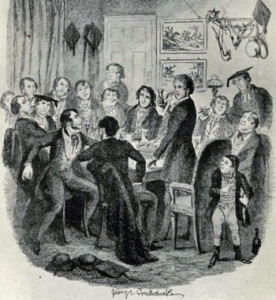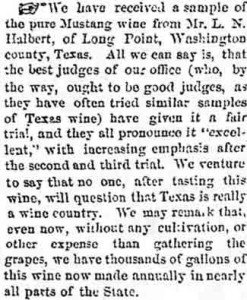
Texas Frontier News: Texas Mustang Grape Wine Judged Excellent!
An article in the Galveston Daily News from October 25, 1868, on the front page no less, caused me to ask the question:
In the 1860s, what characteristics must a locally produced Texas wine, and especially a local Texas native Mustang grape wine, possess to show well?
Here is the article from the Galveston Daily News:
Shown above is the first use of the words “Texas” and “Wine Country” in the same sentence.
This article also extols the virtues of our local Texas grape wine made from Mustang grapes harvested in the wild and made into wine by N.L. Halbert in Washington County, just a few days travel up the Austin trail from Houston by horseback.
Even after a lot of thought on the question I posed, it is was hard for me to discern an clear answer. So, I tried to rationalize one.
Recall, in Texas, the 1800s were a time of hot dry dusty trails, hot dusty saloons and hot dusty homes prior to the advent of air conditioning and refrigeration. Shipments were by slow boats, bumpy trains and/or wagons. Texas was a place far afield from the center of European wine production and it was also a place where ice was a precious commodity, definitely scarcer than diamonds and rubies.
My first question turned into a second question: How did they store and transport wine (it must have been a difficult issue) back then? This made questions of proper serving temperatures for wine to be of little relevance.
Knowing that Mustang grapes are the most sour and acidic of many native grape varieties that grow in Texas, the proclamation that this Mustang wine was “excellent” made me look for a proper perspective on the subject.
Being hot and far away from the major wine centers, must have been a challenge for European wines. What were these wines like after the month’s long trip by ship to Galveston (likely in barrel) and after being bottled and stored in a hot Galveston warehouse, and perhaps even land shipping for distribution around the state? My bet is that they were not anywhere close to their optimal condition and likely were bad tasting most of the time.
Now compare… We have the good Mr. N.L. Halbert in Washington County just up the road harvesting Mustang grapes in September and shortly thereafter making his wine using the time tested formula for Mustang wine – Addition of sugar, sugar and more sugar! He likely finished fermentation, a short barrel aging and bottling the wine in the cool breezes of a Texas November. He then, lofted a few bottles to the journalists at the Galveston Daily News and they gladly (maybe even festively) tasted the wine in December – Note that the scores for the wine appear to have gotten better the more the tasted imbibed (a typical thing that happens even today).
My opinion is that a fresh Texas Mustang wine likely had attributes leading to the journalists proclamation that it was “excellent”, especially if it was compared to a fine European wine that did not travel well in its months long trip to Texas and it’s time in hot storage.
The lesson here is not to judge a wine only by the norm of the present day (modern transport and storage, refrigeration, service temperature, etc.). I say this particularly if the question pertains to the wines of our frontier Texas – à votre santé!




Be the first to comment